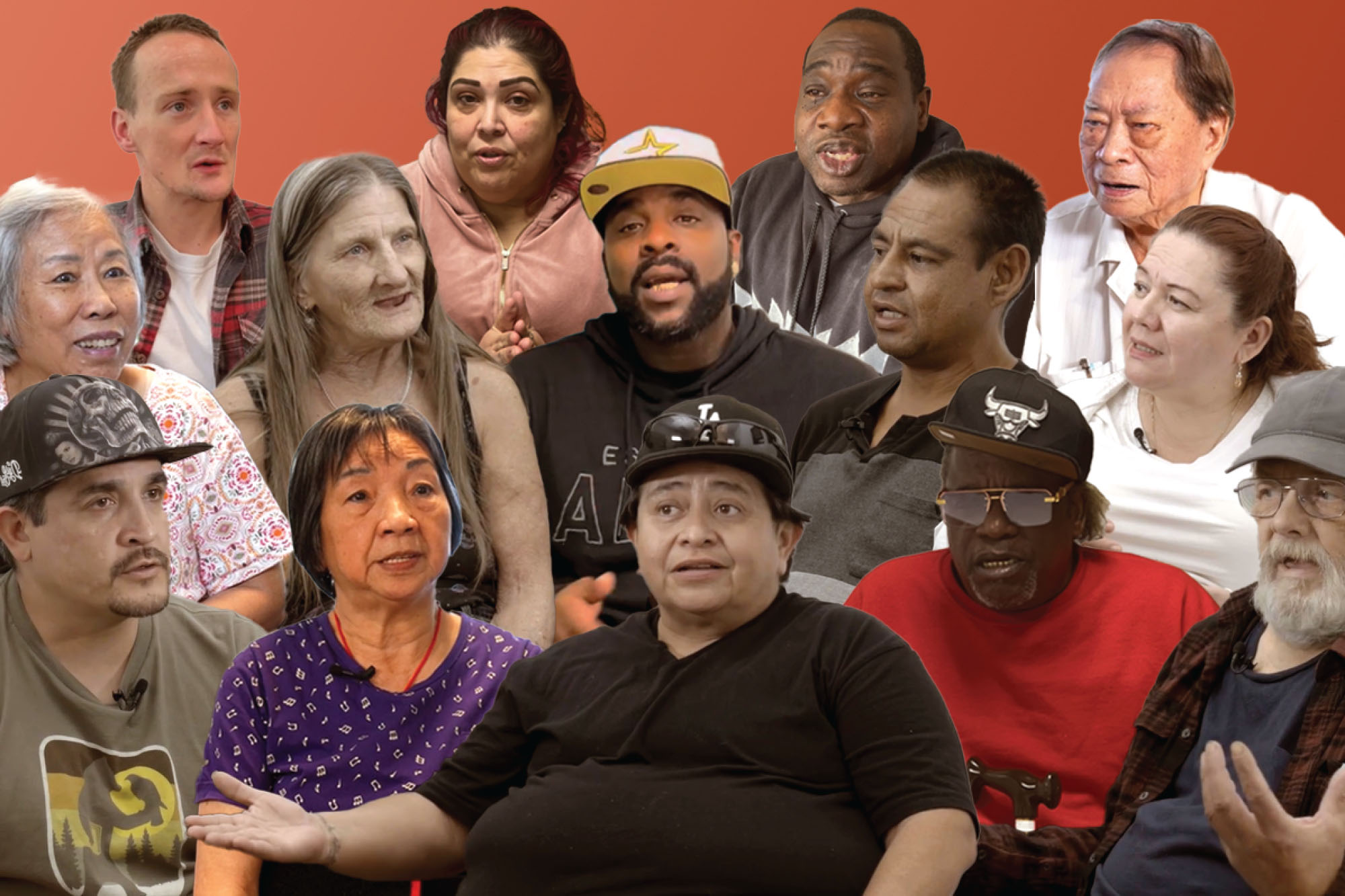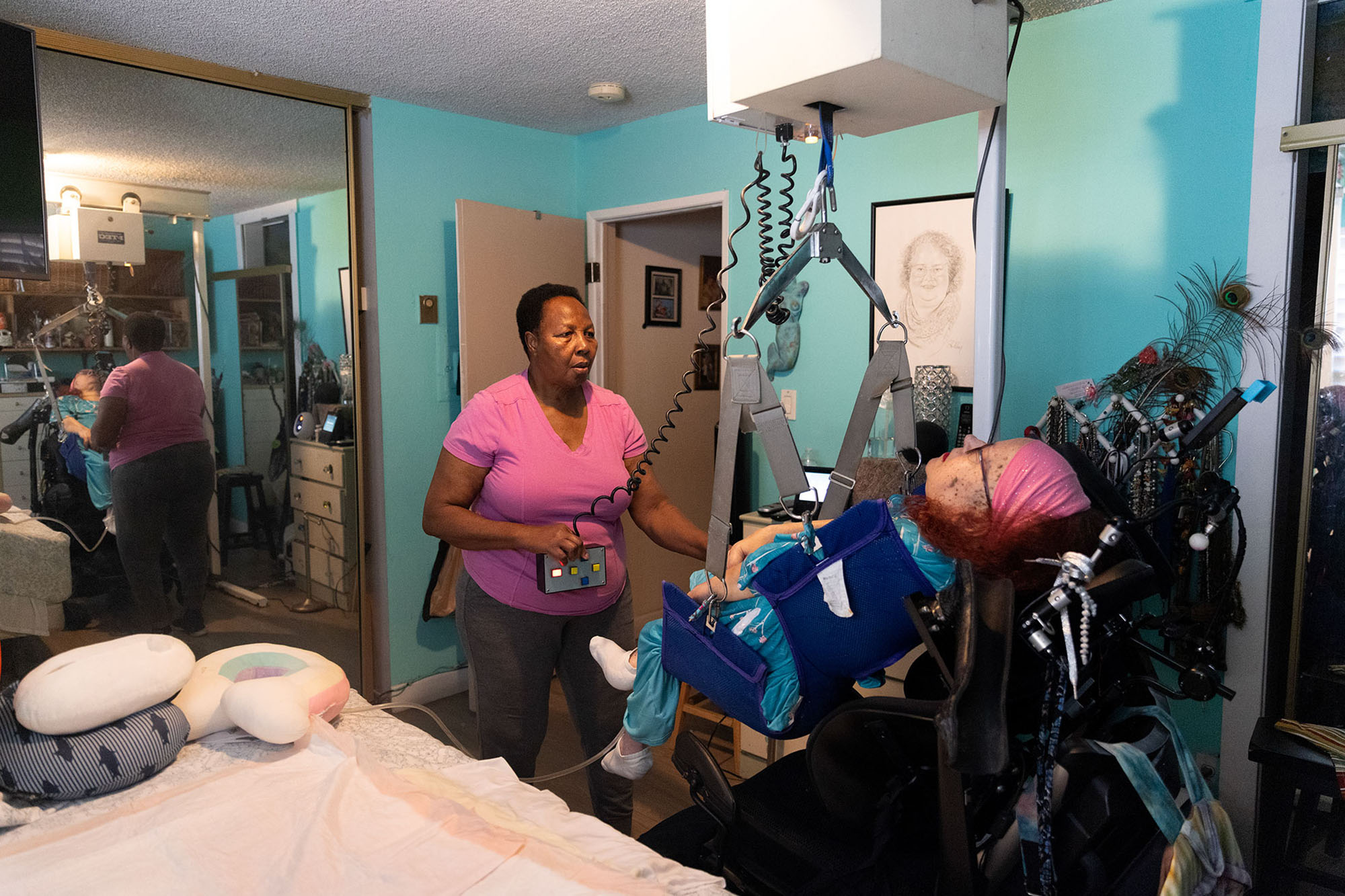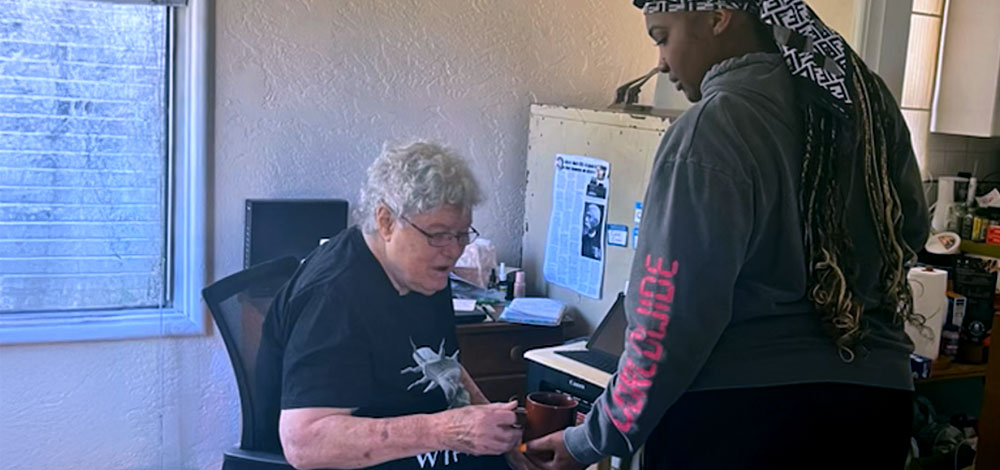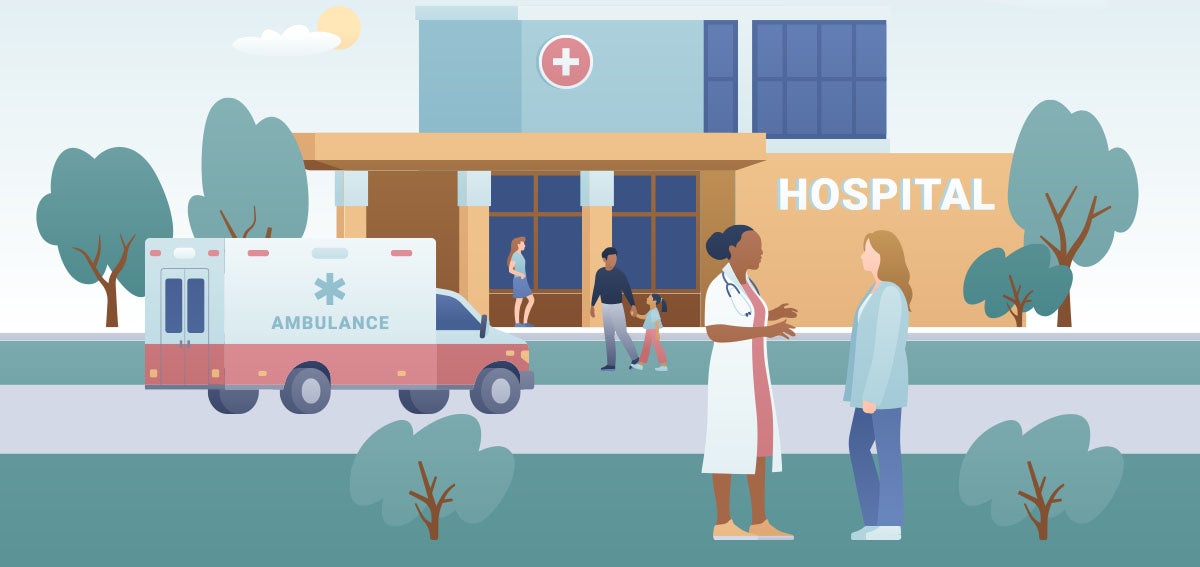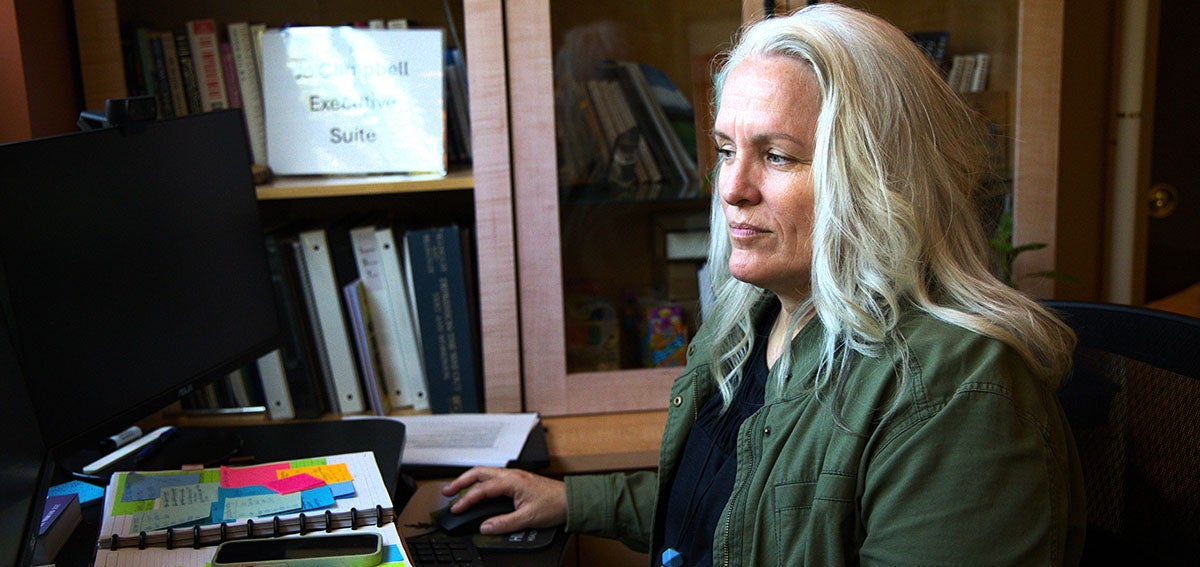|
Getting your Trinity Audio player ready…
|

Evanne Levin of Rancho Mirage has been struggling with a difficult question lately: What will she do if her 101-year-old mother loses her Medi-Cal coverage?
Medi-Cal, California’s Medicaid program, allows Levin’s mother Rose to receive daily in-home caregiving through the In-Home Supportive Services (IHSS) program. That makes it possible for her to live at home despite mobility and memory challenges. Without that support, Levin, 75, who has her own health and financial difficulties, isn’t sure how she would cope.
“I wish I had a good answer, an easy answer,” said Levin, who lives near her mother and helps care for her outside of the four hours a day covered by IHSS. “I cannot be there for her all the time. We would have to look at a facility that accepts Medi-Cal as payment, and if Medi-Cal was going to be cut back, it’s going to impact the facilities as well.”
Across California, Medi-Cal enrollees and their loved ones have been wrestling with similar questions since the US House of Representatives adopted a federal budget resolution that sets the stage for significant cuts to Medicaid.
Levin lives in the congressional district that stretches across Riverside County and includes the cities of Corona, Lake Elsinore, Menifee, Palm Springs, Palm Desert, Indian Wells, and portions of Eastvale and Riverside. Over 256,000 people — about 34% of the district’s population — are covered by Medi-Cal.
The prospect of Medi-Cal cuts has alarmed patients, health care providers, advocates, and caregivers across the region. They fear the budget cuts will harm the working families, seniors, people with disabilities, and children who rely on the program; the providers and institutions that provide services to them; and the broader economy and community. An estimated $11.57 billion in Medi-Cal funding flowed into Riverside County in 2024, according to the UC Berkeley Labor Center. Almost $3 billion of it was to cover the cost of caring for enrollees in the district. That money does more than support providers, clinics, and hospitals; it makes its way to local businesses, households, and city and county tax revenues too.
Struggling Rural Facilities
Jarrod McNaughton is CEO of the Inland Empire Health Plan, a Medi-Cal managed care plan that covers 1.5 million of the approximately 2 million Inland Empire residents enrolled in Medi-Cal. The plan employs 4,000 people, including case managers and community health workers, and contracts with around 9,000 health care providers, hundreds of clinics, and every hospital in San Bernardino and Riverside Counties.
Big reductions in Medi-Cal spending would devastate patients, providers, and the local economy, McNaughton said. He’s especially worried about reduced Medi-Cal support for struggling rural facilities, which could be forced to make massive service cuts, or even close, he said. On average, Medi-Cal accounts for almost 20% of net patient revenue going to hospitals in the congressional district. At certain hospitals, it accounts for more than half.
Other knock-on effects of Medicaid cuts could be that more people with chronic conditions flood hospital emergency departments because they can’t access preventive care, and fewer providers cover Medi-Cal patients because of lower reimbursement rates, McNaughton said.
“You will see catastrophic patient outcomes from these kinds of cuts,” McNaughton said. “You’re going to see a strain on the system for everybody, regardless of whether you’re commercially covered, whether you’re covered by a government program like Medicare or any other program, because now you’re going to have an influx of patients into hospitals that are already going to be stretched so thin.”
Community Clinics Brace for Significant Disruptions
Community clinics would be hurt too, said Andy Piskoulian, CEO of Centro Medico Community Clinic, a nonprofit community health center with five clinics in the Inland Empire, including ones in Corona and Riverside. The organization provides health care to approximately 15,000 patients in the congressional district, almost all of whom have Medi-Cal.
If cuts happen, ancillary services such as dental, vision, and podiatry care could be the first to go, Piskoulian said. Patients could end up waiting months for medical appointments as staffing is reduced, he added. The clinic may also have to slash such programs as free transportation for seniors and acupuncture services that have helped reduce some patients’ needs for addictive pain medications.
Piskoulian said he’s especially frustrated at the prospect of Medi-Cal cuts rolling back progress the center has made in reaching and helping more patients. In the past three years, Centro Medico opened a clinic at a homeless shelter in Corona that expedites the medical tests people need to get off the streets, opened a clinic in a remote desert community where people previously had to drive 30 miles to see a doctor, and began coordinating medical and social services for 800 high-needs patients under CalAIM. The organization also plans to open a resource center in Corona that will provide health classes, social services connections, after-school tutoring, job search help, and other services for area residents.
“We’re like, oh my god, where are we going?” Piskoulian said. “Hopefully this beautiful model that I think would do an amazing service to the community doesn’t fall because of what’s about to happen.”
Polling Finds Widespread Anxiety
Fear over potential Medicaid funding reductions is widespread: a recent poll by NORC at the University of Chicago found two-thirds of Californians are worried that enrollees will not be able to access the same level of benefits in the future. That same poll found broad support for Medi-Cal among Californians across party lines, with 8 out of 10 Democrats and nearly two-thirds of Republicans wanting the program to stay the same as it is today or receive additional funding.
One of those expressing anxiety is Amie Cullop of Meniffee, a retired US Army sergeant who completed two tours of duty in Iraq and now fears that Medi-Cal cuts could make it harder to care for her son Miles. The six-year-old was born with a neuromuscular disease that affects his breathing, mobility, and endurance.
Although Cullop has health insurance through the military, it doesn’t cover all of Miles’ therapies and out-of-pocket medical costs. Medi-Cal paid for the early intervention therapy that taught Miles to sit, eat, walk, and hold a pencil. It now covers occupational, physical, and speech therapies as well as adaptive equipment that allows him to do schoolwork, play the piano, and dream of becoming a pediatric pulmonologist.
“I credit the services he has received to where he is,” Cullop said. “I don’t want to see other families struggling, other kids struggling, especially when I know the good these programs and the funding Medicaid provides can do.”
Barriers to Mental Health Care
Linda Hart, founder and executive director of the African American Health Coalition, worries Medicaid cuts could make it even harder for people with mental health conditions to get treatment. Her organization works in Black communities across San Bernardino and Riverside Counties to provide mental health education and referrals.
Hart’s adult son relies on Medi-Cal to pay for medications to control his schizophrenia and for services that enable him to access to stable housing. Without that support, Hart worries he and others with severe mental illness could become a risk to themselves or others and could put pressure on first responders.
“It’s not just cutting someone off of Medi-Cal, it’s what are the ramifications of when that happens?” Hart said. “You may be thinking about saving money, but you’re going to lose lives.”
At the Inland Caregiver Resource Center in Colton, staff are fielding constant questions from anxious seniors and their caregivers about what potential cuts to Medi-Cal could mean for them, Executive Director Carmen Estrada said. The center, which supports older adults and their family caregivers with counseling, respite, and housekeeping services, works with many people who receive In-Home Supportive Services.
“A lot of the people we see, they’re just making it. Any cut could keep them from staying in the home where they want to be and [lead to them] being homeless or even institutionalized,” Estrada said. “It is definitely a scary time.”
‘Personal and Emotional’
Scared is how Kristine, 68, of Desert Hot Springs feels. Since her husband died in 2018, she has relied on IHSS-paid home health aides to help her with daily tasks such as using the bathroom, preparing food, and going to doctors’ appointments. Kristine, who asked that her last name be withheld because she feels vulnerable, has a type of inflammatory arthritis that left her partially paralyzed and functionally blind.
“I would literally be institutionalized [without IHSS] because I can’t care for myself and my care providers cannot work for free, and I have no family,” she said. “I don’t have someone that can step in that’s not paid to help me. It’s so personal and so emotional that I have a hard time languaging it.”
Back in Rancho Mirage, Evanne Levin said she’s been closely monitoring the news about Medicaid funding coming out of Washington in between the hours she spends every day overseeing her mother’s care.
“I think about all the people who don’t have a me to help them,” she said. “Our elders and those with disabilities should be treated with greater respect … I’m speaking for my mom and me, but I’m also speaking on behalf of all of those that don’t have their own voices.”
Authors & Contributors

Claudia Boyd-Barrett
Claudia Boyd-Barrett is a longtime journalist based in Southern California. She writes regularly about health and social inequities. Her stories have appeared in the Los Angeles Times, San Francisco Chronicle, San Diego Union-Tribune, and California Health Report, among others.
Boyd-Barrett is a two-time USC Annenberg Center for Health Journalism fellow and a former Inter American Press Association fellow.

John Valenzuela
John Valenzuela, a seasoned freelance photographer and former staff photographer for Southern California News Group, captures stories through his lens.

